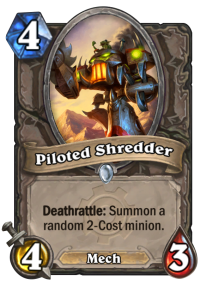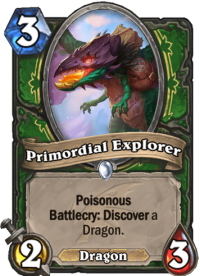Considering it’s one of the Hearthstone community’s favorite terms to throw around, it’s a surprise many aren’t familiar with the precise definition of what power creep actually is. It might seem like rampant perfectionism to some, but if you nail down the specifics of this phenomenon, you’ll have a better understanding of why the cards we’ve seen so far in the new set are so damn good – and why that’s OK in the grand scheme of things.
Creeping Power

Whatever disagreements you may have about the term, it’s clear no one wants to see rampant power creep in their favorite card game. Just ask Yu-Gi-Oh players about how that goes. It comes with that sinking feeling that your old cards can no longer make an impact in the meta, and you always need to upgrade the latest and greatest goodies to keep up with the pack. It’s a delicate balancing act: if none of the cards from a new release shake up the metagame, it will go down in our collective memory as a TGT-like disaster. (Even though it spawned Secret Paladin and included many cards like Alexstrasza's Champion and Totem Golem which would prove crucial in meta-defining decks later down the line.) Whatever the case may be, you don’t want to achieve this goal by printing strictly superior cards to what was previously viable in the meta.
This is the part where most power creep-related misconceptions originate from. Though the exact definition of terms tends to change over time based on usage (just think of how “could be bothered” is slowly becoming a more acceptable form just by the sheer volume of its occurrence – yuck), it’s important to know and understand the original meaning of the term. Basically, real power creep occurs when the power level required for a card to see play increases. Going from Magma Rager to Ice Rager wasn’t that big a deal, because Magma Rager was never viable in Constructed decks to begin with – and for that matter, neither was its cold counterpart. (Whether it was worth printing those jokey cards over and over again for so many sets is another story and shall be told another time.)
As a counterexample, going from Classic’s Chillwind Yeti as the premium 4-drop to Piloted Shredder in Goblins versus Gnomes meant that potential alternatives in the same role had a higher bar to clear. This had Constructed relevance and impacted the deckbuilding decisions across most meta decks at the time. Strictly speaking, it wasn’t the card, but the corresponding slot which was power-crept: the new baseline for a non-archetypal value 4-drop went from Yeti to Shredder.
Is this necessarily a bad thing by itself? The answer to this isn’t straightforward either since there’s another important aspect by which the power levels in a Constructed environment has to be judged: the number of available sets in play at any given time. If you have more cards to choose from, it means that a lower percentage of them will make it into a deck’s limited 30 slots. The difference between the combo potential and goldfishing (ie. how long it takes to kill a passive opponent) is huge between a Standard and a Wild deck, and this is the reason behind this phenomenon.
Just as an aside: the power level of a game mode also depends on the deckbuilding restrictions. Basically, the more control you have over what you play with, the higher the power levels are. Under normal circumstances, a limited format like Arena will not have decks that can compete with Constructed alternatives, no matter what Kripp may say in a salty outburst. Though this doesn’t come into play when comparing Standard environments with each other, it is also an important element in the wider context of power levels.
To some extent, power creep is unavoidable in card games, and considering how long Hearthstone managed to drag out the point until the Standard format will no longer consist of more than half of the total pool, there’s a good argument to be made that the effects were fairly tame so far overall.
Dread and Drakes

So how does this relate to the insane cards we’ve seen from the Descent of Dragons set so far? As powerful as they are, the combination of a large card pool and the fact that it’s from an end-of-year expansion makes them OK strictly from a power level perspective.
Sometimes the fact that these sets are clearly stronger than the previous ones are is decried as a cynical money-making exercise. In fact, the opposite is true in some sense: you’d be cheated out of value if this wasn’t the case. If each set in a Standard rotation had the exact same power level, the ones released later during the year would simply be worth less – seeing play for fewer rotations for the same price –, which would be another source of justified outrage. (In fact, just think back to the complaints about Rastakhan’s Rumble to think of the opposite outcome.) Having stronger cards in end-of-year sets solves this issue while also ensuring variety in the metagame.
The real issue with these cards doesn’t stem from power level considerations but from the negative side effects of Team 5’s card design philosophy. Unlike other card games, which tend to give you a LEGO box set and let you build whatever you want, most Hearthstone sets pretty clearly lay out the archetypes you can play in advance. In fact, the deck recipes often serve as a decent representation of the potential builds out there. (Even Patron Warrior had a fairly well-built version in Blackrock Mountain for you to mess around with.) Arguably, Keleseth Rogue and Dragon Tempo Warrior from TGT serve as the two decks which came from a total mishmash of archetypes and little direct synergistic support: almost everything else was basically pre-cooked by the devs.
Looking at the DoD cards we’ve seen so far, I’d argue the potential source of frustration isn’t necessarily their power level, but their narrow application. When combined, the two do pose a major issue, even if there’s no concern about power creep: Breath of Dreams will only see play in slow, Dragon-filled Ramp Druid decks while Fiendish Rites only makes sense in Zoo-esque Warlock builds. Of course, Invoke and the “if you’re holding a Dragon” keywords are fairly poor from this perspective as they both come with fairly specific deckbuilding restrictions. It remains to be seen how these elements will combine – and how aggressively railroaded the other archetypes are in Descent of Dragons. This, not the admittedly high power level, will be what likely determines the enjoyment value of the last set of the Year of the Dragon.

Good read. Do you think they would destroy Galakrond at the end of year of the dragon? Hearthstone has become more story driven this past year. Removing an extremely OP card going into the expansion after DoD.
So basically the new expansion might give us strong cards? Ya think! Balance is the goal of every expansion… am I missing something here?
I feel like the dragon push in this set does a very good job of adding competitive archetypes to the meta without pushing “answers” to current decks in the meta. The net result being a greater amount of diversity.
so, to understand power creeping in a simple way, it’s neither the minion on the board you want to destroy most nor the minion with premium stats.
but the ability to synergize all your cards into power play, that fit the situation best?
but what about taking fatique into consideration when all else failed?